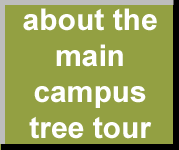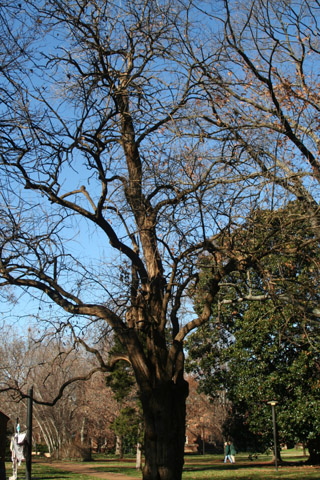 |  |  |  |
An individual instance of Maclura pomifera (osage orange)

Permanent unique identifier for this particular organism:
http://bioimages.vanderbilt.edu/vanderbilt/7-299
Notes:
This tree grows in front of the Rand wall near the intersection of two sidewalks on the Rand/Sarratt side.
Osage orange is an example of a dioecious (i.e. individuals either only male or only female) species. This particular tree is a female, but doesn't produce fruit every year. In the fall, the strange, lumpy fruits may be found lying on the ground below female trees.
Horses are one of the few animals known to eat this fruit and potentially disperse its seeds. Given that horses are not native to North America, it is likely that the species' original disperser (probably a large mammal) died out during the mass extinction that occurred soon after the arrival of humans in North America. If it is true that this tree was dispersed by extinct mammals, it may have been saved from extinction by Native Americans who favored its wood for use in bows. Later, European settlers spread it throughout the central U.S. when they planted it as thick hedges to keep in livestock - hence one of its common names: hedge apple.
Notice how the branches arch out and downward. The inner bark has a distinctive orangish brown color. Close examination of the twig will reveal small, sharp spines.
Osage orange is an example of a dioecious (i.e. individuals either only male or only female) species. This particular tree is a female, but doesn't produce fruit every year. In the fall, the strange, lumpy fruits may be found lying on the ground below female trees.
Horses are one of the few animals known to eat this fruit and potentially disperse its seeds. Given that horses are not native to North America, it is likely that the species' original disperser (probably a large mammal) died out during the mass extinction that occurred soon after the arrival of humans in North America. If it is true that this tree was dispersed by extinct mammals, it may have been saved from extinction by Native Americans who favored its wood for use in bows. Later, European settlers spread it throughout the central U.S. when they planted it as thick hedges to keep in livestock - hence one of its common names: hedge apple.
Notice how the branches arch out and downward. The inner bark has a distinctive orangish brown color. Close examination of the twig will reveal small, sharp spines.
 |  |
Load database and switch to thumbnail view
Use this stable URL to link to this page:
http://bioimages.vanderbilt.edu/vanderbilt/7-299.htm
This organism is a living specimen that is part of the Vanderbilt University Arboretum with the local identifier 2-250.
This particular organism is believed to have managedmeans of establishment.
This organismal entity has the scope: multicellular organism.
Identifications:
Maclura pomifera
(Raf.) C.K. Schneid.
sec. fna.org 1993
common name: osage orange
family: Moraceae
Identified 2013-12-11 by Steven J. Baskauf
Location:
Vanderbilt University, Nashville, Davidson County, Tennessee, US
Click on these geocoordinates to load a map showing the location: 36.14643°, -86.80253°
Coordinate uncertainty about: 10 m.
Location of individual determined from GIS database.
Occurrences were recorded for this particular organism on the following dates:
2013-12-11
2014-09-03
The following images document this particular organism.
Click on a thumbnail to view the image and its metadata.Load database and enable navigation by taxon and organism.
| Image | View |
 | whole tree (or vine) - general |
 | whole tree (or vine) - general |
 | whole tree (or vine) - winter |